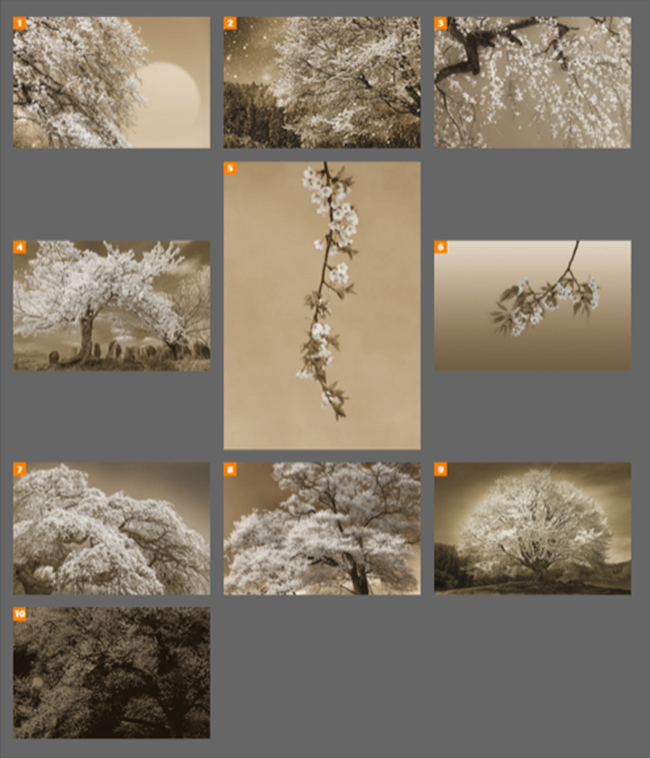
Statement
Basically, in my photographic series of 'Nippon', I tried to integrate Japanese traditional artistic elements into the modern digit al art of photography. I choose cherry blossom as a motif of my pictures this time.Because the cherry blossom has been a symbol of Japanese people's soul and has a special meaning to us since ancient times.
Hideyoshi Toyotomi who is regarded as one of Japan's great unifiers had planted 700 cherry blossoms in Daigoji-temple, Kyoto, in 1598. He invited 1300 people to this temple and held an enormous cherry blossom viewing party. He knew that the cherry blossom is so gorgeous that it never fails to grab people's heart. He identified his glory of his achievement with the cherry blossoms and he tried to show the greatness of his power. It is the anecdote about the strong relationship between Japanese people and the cherry blossoms.In the late 1800s, at the time of the Meiji restoration, the cherry blossoms had been planted after another all over Japan. This blossom became widespread among the common people and became the spirit of our hearts.In the rapid social changing as opening the country to the world, we needed to unite against foreign countries as Japanese. During the World War I and II, the cherry blossoms became a symbol of the military virtue of which they live gracefully and never be scared of death. The life of cherry blossom is very short. It blooms all at once and falls soon. Soldiers portrayed themselves as the life of the blossoms. After the war, it became a symbol of the reconstruction and the peace.For Japanese people spring is the time to start something new. We fill our hearts with hope and dreams. As a flower of spring, we celebrate cherry blossoms.
The cherry blossom keeps changing its existence value with the times. And it has remained in a broken line as the Japanese symbol until today. And it is figuratively expressed as the sense of beauty and the view of life of Japanese people.I want to express those sense by using Japanese traditional technique in a new digital art of the photographs.
Reviewer Feedback
Dear Hiroaki,
Thank you for sharing your images with the jury. It is satisfying to behold your elegant compositions and experience this Japanese national symbol with such grace. You present a well-written, detailed history of the cherry blossom. Understanding the roots of the cherry blossom traditions greatly enhances the viewer's appreciation for your ethereal images. I especially like that it is not important in what order the photographs and the statement are seen. If the images are seen first, the dreamy otherworldliness communicates a cultural significance and celebration of the cherry blossoms very effectively. The statement then fills in the historical gaps. Or if the statement is read first, the images then bring this history to life.
When selecting images, I would consider the edit and sequence to the maximum effectiveness. There is no need to submit ten images, if a shorter edition is more to the point. With this in mind, I wonder if you could have closed on a stronger note, if you had cut one or two images at the end.
Please also be careful not to overdramatize your photographs. In some images, like image 9, the sky seems overly darkened. Your work is already quite beautiful, especially images 2, 3 and 5 stand out in their joyous and elegant celebration of the cherry tree's timeless form. Lastly, I wonder if the sun and moon have a different significance in Japanese visual arts as they have in Western art. You will have to be the judge what is appropriate, but their appearance in your photographs seem overly pronounced.
It was a pleasure to see your work. Please continue.
Additional Recommendations
Recommended Books
Minor White: Manifestations of the Spirit, by Paul Martineau
What is a Photograph?, By Carol Squires
Michael Kenna
Recommendations for Gaining Exposure
Shots Magazine
Relevant Quotes from Past Jurors
"The work needs to provoke me in some way through ideas and/or composition as a single image or as a series. I am very interested in how the works communicate and make me think." — Louise Clements, Artistic Director, QUAD & FORMAT International Photography Festival, Derby, UK
"Does the image tell the story or illustrate the photographer's vision clearly? The difference between a good photograph and a great one can be subtle, but a great photograph evokes an emotion/connection in the viewer. — Patricia Lanza, Director of Talent & Content, The Annenberg Space for Photography, Los Angeles, CA, USA
"For me, it always starts with a gut feeling, something about the image that reaches out and forces me to pay attention. Whether it's the subject matter, or a powerful composition, or a masterful use of light, or a new way of seeing something I thought myself familiar with — something about the image really has to catch my eye. After that, I look for signs of craftsmanship, storytelling and intent. I am in awe of photographers who can manage to capture a fleeting moment with skill and artistry. Based on the overall context of the competing entries, does the image powerfully evoke a reaction in the viewer, does it engage and tell a story well? In the end, it's a subjective judgment and it also depends on the composition of the competing entries." — Alan Taylor, Editor, The Atlantic In-Focus Photo Blog, Natick, MA, USA
"Remember, without editing, there is no articulation. Selection and ordering means creating authority over your expression. It is what makes music out of noise, or meaning out of words. Photographic editing is somewhere in between music and (linear) writing." — Erik Vroons, Chief Editor, GUP Magazine, Amsterdam, The Netherlands
蓮見 浩明様
フォトレビューでは作品を見せていただき、ありがとうございました。洗練された構成と日本のシンボルともいえる桜の優雅さにふれ、非常に満足のいくレビューとなりました。ステートメントもよく書けており、桜の歴史を詳細に述べ、日本の桜のルーツがよく分かりました。それらを踏まえて鑑賞するので、作品への理解も一層深まり非常に高い評価につながったと思います。私の場合ですが、写真とステートメントの順序はさほど重要にとらえておらず、評価に影響はありません。例えば写真を先に見た時、このなんとも言えない幻想的な世界が、日本らしさと桜が咲く喜びを実に効果的に表現していると感じました。そしてステートメントによって作品に対する理解がさらに深まりました。逆に、ステートメントを読んでから写真を見ると、桜にまつわる歴史が生き生きと伝わってきました。
どの作品を選ぶかにおいては、私は編集の仕方、写真の配列をよく見ます。最大限の効果を引き出せているか、ということです。少ない数の方がまとまりが良いと思えば、必ずしも10作品全てを見せる必要はないです。これらを念頭において私の意見を言わせもらえるならば、もし、蓮見さんが最終的に1作品もしくは2作品くらいに絞り込んでいたら、もっと高評価が得られたのではないかと思っています。
また、自分の作品をあまり大袈裟に表現しないように気をつけてください。例えば作品9(image 9)ですが、空が過度に暗く表現されているように見えます。蓮見さんの作品は十分に美しく表現されていて、とくに作品2と3と5(image2,3,5)はその表現力が際立っています。周りが喜びに満ちあふれ、時代を超えて受け継がれてきたその雅な世界が写し出されています。最後に付け加えるならば、日本でのアートにおける月と太陽の持つ意味合いが西洋のものとは違うのだと感じました。ふさわしい表現というものは、自分の感性で決めなければいけません。しかし今回の作品の中では、月と太陽が大げさに表されていると感じました。
蓮見さんの作品を見せていただきありがとうございました。これからも引き続き頑張ってください。
推奨文献
マイナー・ホワイト:精神の現れ ポール・マーティノー著
(Minor White: Manifestations of the Spirit by Paul Martineau)
写真とは何か? キャロル・スクワイアーズ著
(What is a Photograph? by Carol Squires)
マイケル・ケンナ
(Michael Kenna)
推奨アート市場
ショッツ マガジン
(Shots Magazine)
過去のフォトレビュアーのコメント
良い作品というのは、たとえ一枚の写真であっても連続の作品集であっても、そのアイディアと構成によって私の中の何かを呼び覚ますものでなくてはならない。写真が伝えようとしているもの、そしてそれによって考えさせられることに非常に関心を持っています。(ルイーズ・クレメンツ:アートディレクター、クワッドアンドフォーマット・インターナショナル・フォトグラフィー・フェスティバル、ダービー、イギリス)
‘写真はストーリーを語ってくれるか?そして写真家のビジョンをはっきりと表しているのだろうか?良い写真とすばらしい写真の違いはほんのわずかだ。しかしすばらしい作品というのはビュアーの心と感情を揺さぶるものである。 (パトリシア・ランザ:ディレクター、タレントアンドコンテント・アネンバーグ・スペース・フォー・フォトグラフィー、ロサンゼルス、カリフォルニア、アメリカ)
‘私にとって良い作品はいつも直感で決まる。手を伸ばしたくなるような、目が釘付けになってしまうような作品である。テーマがどうとか力強い構成とか、光の使い方がどんなにか優れているかではなく、初めて見た時からその作品に親しみが湧き、目を捕らえて離せなくなるようなものである。その写真の技巧やストーリー、伝えたい事などは、後からゆっくり探すのだ。技術と才能で、はかない一瞬をとらえることができるフォトグラファーを尊敬している。出展作品コンペを意識した写真が、ビューアーの心を十分に打つ作品になりうるだろうか?そこから真のストーリーが伝わるのだろうか?素晴らしい作品というのは、最終的には個人の主観であり、コンペのテーマによっても違うのだ。(アラン•テイラー、エディター、アトランティック•インフォーカス•フォトブログ、ナティック、マサチューセッツ、アメリカ)
編集なしに良い調音はありえない。言葉を選び並べ替えることは、自分の表現を超えた権威を生み出すことだ。これは音楽を作る際に大事なことで、雑音のような音から素晴らしい音楽が生まれたり、単なる言葉の羅列から人の心を動かすような詞が生まれたりする。写真の編集も音楽と作詞の関係に似ていると思う。(エリック・ヴルーンズ、チーフエディター、GUPマガジン、アムステルダム、オランダ)

